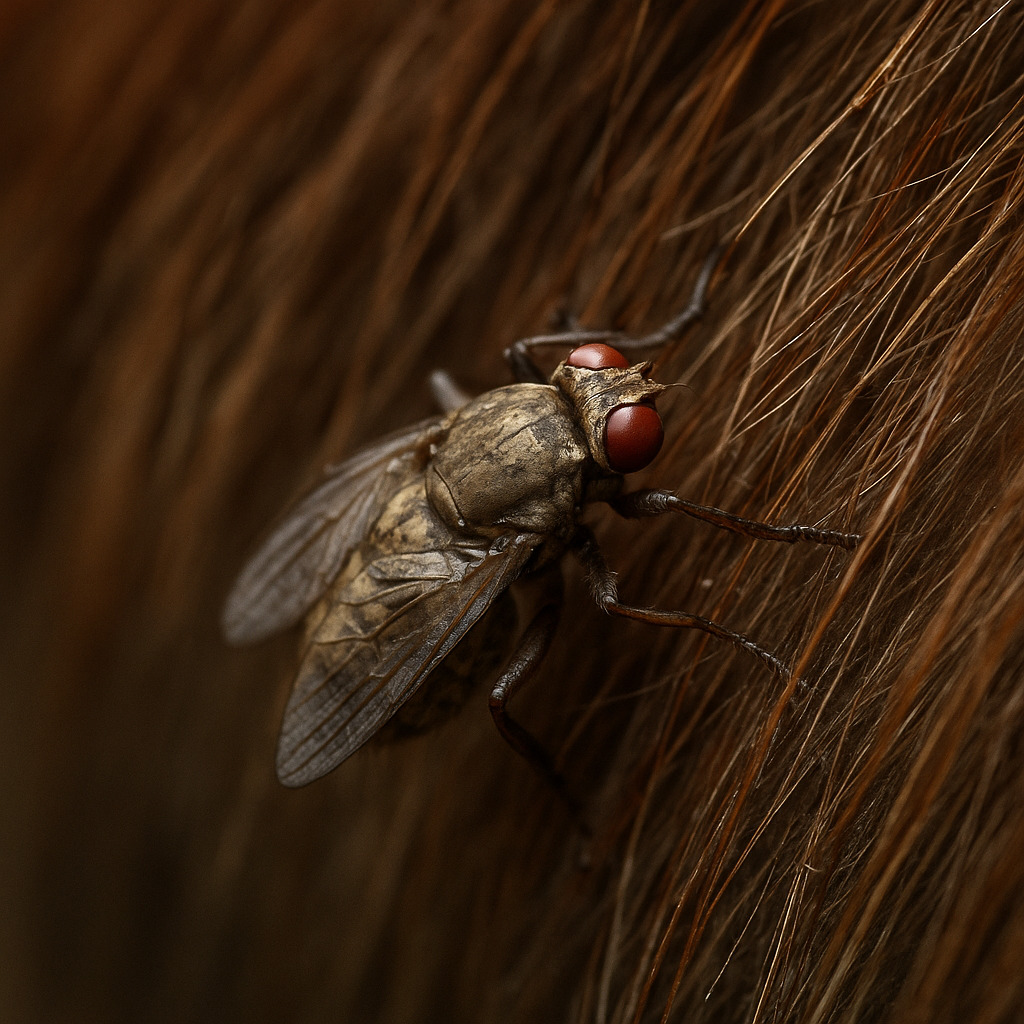It doesn’t buzz. It doesn’t sting. And it barely flies. Yet once it lands on you… good luck getting it off.
If you think all parasites are loud, ugly, and aggressive—then you haven’t met Hippobosca equina, the real horse fly parasite.
It doesn’t need dramatic bites or acrobatic flights to ruin your day. Instead, it crawls silently between hairs, nestles in, and drinks blood with calm, parasitic finesse.
Let’s dive into the bizarre yet fascinating life of this bloodsucking insect and understand why every horse hates it—and why you should know it too.
🧬 Anatomy of a Silent Stalker
Small, flat, and clingy, Hippobosca equina measures just 6–8 mm, but behaves like it owns the stable.
Its body is flattened, evolved to slip between horse hairs with ninja-like stealth. The wings are stiff and short, rarely used beyond a clumsy hop.
Its compound eyes? Bulging like two red searchlights.
Its mouthparts? A precise piercing-sucking apparatus, designed not to hurt—just to steal.
It doesn’t attack. It settles in.
In short: a real horse fly, but with class.
👔 What About the Male?
Yes, there’s a male too—identical to the female at first glance, but less hungry and more hormonal.
He feeds on blood occasionally, but his main goal? Mating, fast and discreet, before getting flicked off by a horse tail.
He doesn’t help raise offspring (nobody does, actually). But among parasites, that’s considered tradition.
Let’s say this: he’s less of a threat, but still a parasite through and through.
🐎 Ideal Habitat: Warm, Hairy, and Full of Blood
Its dream vacation? A sweaty horse in August.
This horse fly parasite loves hot, humid places with large mammals: stables, pastures, forest edges.
It anchors itself on specific body zones: under the tail, between hind legs, along the mane—where hooves and teeth can’t reach.
Unlike random insects, it’s a specialist. She selects her victim, grabs on, and gets to work.
🧲 What Attracts It (and What Doesn’t)
This bloodsucking insect has very specific tastes:
Likes:
- Body heat
- Sweat and strong smells
- Movement
- Dense fur and exposed skin folds
Hates:
- Windy days
- Specialized repellents
- Clean, smooth, scentless skin
If you’re a shiny human with no body hair: you’re boring.
If you’re a sweaty horse: you’re a walking buffet.
🤰 A Reproductive Strategy Worthy of Sci-Fi
The female doesn’t lay eggs like some amateur. No.
She incubates a larva inside her own body until it’s nearly mature. Then she drops it on the ground, ready to become a pupa.
Usually, she does this under the horse, ensuring the larva’s first meal is waiting just above.
Efficient? Absolutely.
Creepy? Also yes.
🩸 Is It Dangerous?
To humans, not really. But for horses? This parasite is a nightmare.
It can cause:
- Skin irritations and lesions
- Weight loss from stress
- Constant tail swishing and anxiety
- Secondary infections
- Aggression or refusal to be mounted
In stables, a full infestation is hell on hooves.
🧯 How to Keep It Away
Protecting horses takes vigilance:
- Daily grooming and coat checks
- Special insect repellents (not just citronella)
- Protective mesh blankets and fly masks
- Keeping the stable dry and clean
Often the only sign is a nervous horse with nothing visible… until you part the fur and see her, clinging like a tick with wings.
🪓 Small, Sticky, and Unreasonably Annoying
Hippobosca equina doesn’t buzz or attack.
It colonizes.
It’s the real horse fly, the one vets mutter about, the one that hides in plain sight.
Quiet. Sticky. Persistent like a bad thought at 3am.
No drama. Just blood.
And it always wants seconds.








Leave a Comment